- Clinical Technology
- Adult Immunization
- Hepatology
- Pediatric Immunization
- Screening
- Psychiatry
- Allergy
- Women's Health
- Cardiology
- Pediatrics
- Dermatology
- Endocrinology
- Pain Management
- Gastroenterology
- Infectious Disease
- Obesity Medicine
- Rheumatology
- Nephrology
- Neurology
- Pulmonology
Skin Disorders: 5 Shots, 5 Tips (Series #5)
Here: Dr Rosen presents 5 tips about 5 skin disorders that you might not know.
Case 1
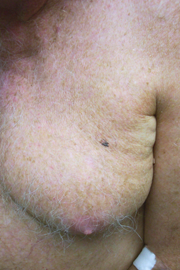
Older adult presents with concern about a specific asymptomatic lesion on his chest of unknown duration. History includes extensive solar exposure without sunscreen use.
Key point: The shape is somewhat irregular with a prominent notch to the left side; there is irregularity of pigment as well. These signs suggest a high probability of malignancy, with pigmented basal cell carcinoma and malignant melanoma being most likely.
Treatment: Either an incisional or excisional biopsy is mandatory. Because of the relatively small size, complete removal is probably preferable in this case.
Note: The lesion ended up being a superficial spreading malignant melanoma, 0.37-mm thick, with only rare mitoses visualized on histology. Following excision, this thin, stage IA lesion carries a good prognosis (97% 5-year survival).
Case 2
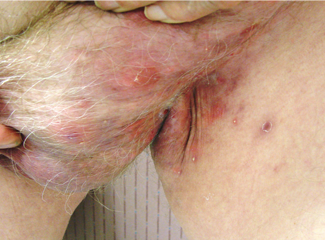
An older, obese, diabetic patient presents with intense itching and burning in the groin and on the scrotum.
Key point: This is intertrigo, or multi-faceted, inflammation involving skin folds. The presence of discrete pustules suggests either staphylococcal or candidal involvement. A pustule roof should be examined under potassium hydroxide for the presence of yeast, and the pus from another lesion sent for bacterial culture.
Treatment: Attempt to keep the area dry (eg, Domeboro soaks) and administer appropriate, specific therapy depending on the microbiologic findings.
Note: Heat and moisture in this area predispose to intertrigo, as do diabetes and obesity. Weight loss would reduce skin-on-skin friction and reduce the risk of recurrence.
Case 3
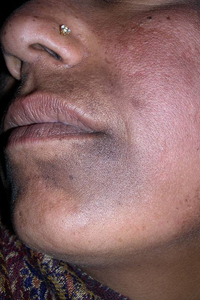
Middle-aged Pakistani woman has been applying a “bleaching” cream to a small dark spot on her face. Instead of removing the spot, she has paradoxically developed a widespread area of increased pigmentation.
Key point: With few exceptions, “bleaching” products (prescription and over-the-counter) contain hydroquinone. Products obtained outside the United States can contain very high concentrations of the active ingredient. The hydroquinone then actually deposits in the dermis and is called exogenous ochronosis.
Treatment: Discontinue application of hydroquinone. Select laser interventions may be of benefit.
Note: This is especially common in association with skin “bleaches” obtained in South Africa and Southeast Asia.
Case 4
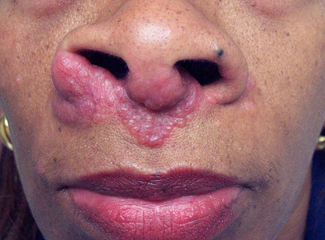
33-year-old African American woman presents with asymptomatic, slowly expanding, firm, reddish purple plaques at the distal nose and within the nasal septum. Her only additional complaint is dyspnea on exertion.
Key point: This lesion has the classic appearance of cutaneous sarcoidosis. The patient’s age, gender, and ethnic demographic all support this diagnosis. A chest film revealed both hilar adenopathy and parenchymal fibrosis, consistent with pulmonary sarcoidosis.
Treatment: Oral antimalarial drugs are first-line therapy, to which systemic corticosteroids or methotrexate can be added as needed. Recent reports highlight use of TNF-alfa inhibitors in severe cases.
Note: Skin biopsy reveals noncaseating granuloma formation. Hypercalcemia and hypergammaglobulinemia should be sought.
Case 5
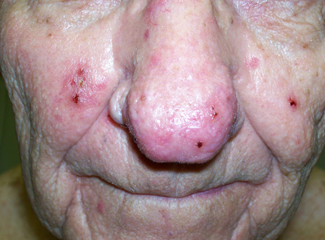
A 73-year-old patient presents with recent onset of “acne.” He wonders if his diet is responsible.
Key point: In the absence of an inciting drug, acne this late in onset is almost always actually rosacea. The clinical absence of comedones and presence of papules and pustules, along with erythema and telangiectasia of the face, are typical features.
Treatment: Topical metronidazole, azelaic acid, and sulfur products, along with oral tetracycline derivatives, are standard treatments. Flushing and blushing aggravate the situation, so avoidance of extreme heat and stressful events is helpful.
Note: Unlike the situation in adolescent acne, diet is felt to play a significant role in rosacea pathogenesis. Hot (temperature and seasoning) food or beverage should be avoided, as should cheese-containing products.
